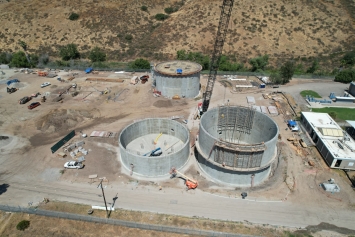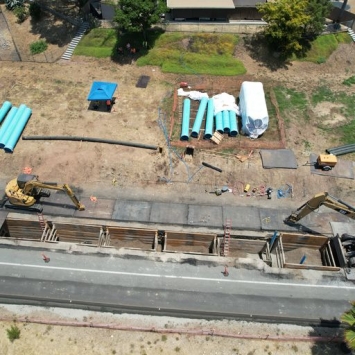Original Article: Click Here
By Mike Allen

August 4, 2023 (Santee) — One year into the construction of the $950 million East County Advanced Water Purification Program (AWP_, the largest infrastructure project in the region’s history is starting to take shape.
Huge concrete and steel structures with names such as digesters, headworks, clarifiers, equalization tanks, and aeration basins are sprouting at the end of Fanita Parkway in Santee where the Ray Stoyer Water Recycling Plant used to exist.
The facility that once produced some 2 million gallons of water used for irrigation is being transformed to a far larger entity that will produce some 11.5 million gallons of drinkable water daily for about 500,000 East County residents.
The massive project has been planned for about a decade, and broke ground in June 2022. It’s scheduled to be finished by the end of 2025, and begin operating by 2026.
The lead agency for AWP, the Padre Dam Municipal Water District, provided ECM with a recent tour of the site to give a glimpse into how things are unfolding. Three other agencies make up a joint powers agency that oversees AWP: the county of San Diego, the city of El Cajon, and the Helix Water District.

Plenty of advance notice was given for the traffic disruption on that street and Mast Boulevard by Padre Dam, but delays are inevitable when a project of this scope is being built, water officials said.
At its peak, the AWP will have some 250 workers on the job toiling on five different packages, the largest of which covers the transformation of the Ray Stoyer facility, and is estimated at $460 million.
Package 2 entails an 11 mile pipeline that takes the near distilled quality water east to Lake Jennings. Package 3 consists of changes to the existing Mission Gorge Pump Station, and pipes connecting to the new water recycling plant and a brine line connecting to the city of San Diego’s sewage lines.
San Diego is concurrently building its own water reclamation system called Pure Water centered in Miramar at an estimated cost of $5 billion.
Similar water reclamation systems have been operating in Orange County, and other parts of Southern California for decades as the cost of importing water from the Colorado River and the Sacramento River Delta become too expensive. AWP is said to provide about 30 percent of the region’s supply once it’s completed.
Franz Schauer, construction manager for Package 1, said what’s being created is an expansion and enhancement of what was going on at the Ray Stoyer plant, which was created in the 1950s. Once the sludge goes through three levels of treatment to produce the same type of water at the old facility it goes through a final stage of purifying the water for drinking.
“If you want to call (the project) it’s really three treatment plants put together,” Schauer said. Once the process gets to the purification stage, the water goes through micro-filtration process, and finally to another larger building where it goes through reverse osmosis, he said.
At the end point, the near distilled quality water is pumped to Lake Jennings where it will be held and receive yet another level of purification before it’s pumped to customers.
After about a year, the AWP has spent $106 million in construction, installed some 875 linear feet of pipes, and poured some 10,000 cubic yards of concrete. The Package 1 contractor is a joint venture of AECOM and W.L. Lyles Construction.
The workers on this job usually possess more specialized skills endemic to wastewater treatment facilities, Schauer said.
“A lot of this work that we do in wastewater takes a special type of person. We’re not building a hotel, we’re not building a mall.”
